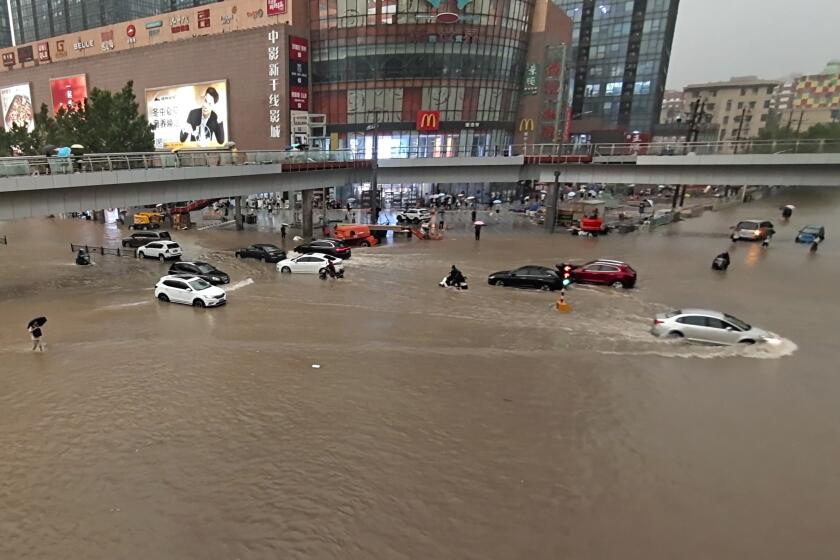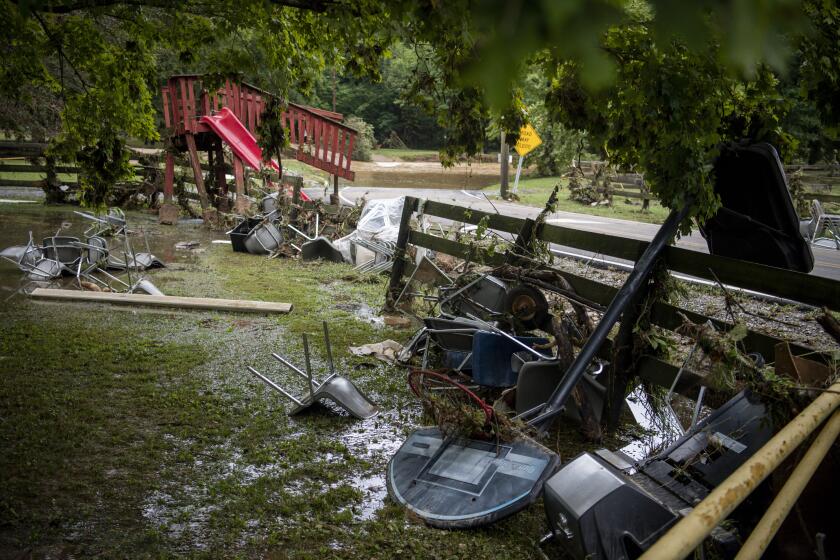Moving inland, Tropical Storm Henri drenches Northeast

- Share via
WESTERLY, R.I. — Tropical Storm Henri socked the Northeast with heavy wind and rain as it made landfall Sunday on the coast of Rhode Island, knocking out power to more than 140,000 homes and causing deluges that closed bridges, swamped roads and left many people stranded in their vehicles.
The storm was downgraded from a hurricane before reaching New England, leaving many to breathe a sigh of relief, but the National Hurricane Center warned the slow-moving storm would continue dumping heavy rains on wide swaths of the region well beyond the weekend.
Over two days, heavy, sustained rains flooded areas as far southwest as New Jersey, even as it took on tropical depression status.
The storm threatened to stall near the New York-Connecticut border overnight before pivoting to the East and moving out to the Atlantic Ocean on Monday night. Some of the highest rain totals were expected inland. There were few early reports of major coastal damage due to wind or surf.
President Biden on Sunday promised to provide federal help to the residents of affected states. The president declared disasters in much of the region, making more federal recovery aid available.
Climate change is making the world more prone to floods like those in China and Europe and to heat waves and fires like those in the U.S. and Russia.
Biden earlier had offered his condolences to the people of Tennessee after severe flooding from an unrelated storm killed at least 22, including young children and elderly people, and left dozens of others missing.
When it made landfall near Westerly, R.I., Henri had sustained winds of about 60 mph and gusts of up to 70 mph, according to the National Hurricane Center. By late Sunday, Henri had sustained winds of about 30 mph as it moved inland across Connecticut toward the New York state line.
Some of the worst rain arrived well before the storm’s center. In Helmetta, N.J., some 200 residents fled for higher ground, taking refuge in hotels or with friends and family, as floodwaters inundated their homes.
“It came so quick — in the blink of an eye,” said the town’s mayor, Christopher Slavicek, whose parents were spending the night after fleeing their home.
“Now there’s cleanup. So this is far from over,” the mayor said.
Some communities in central New Jersey were inundated with as much as 8 inches of rain by midday Sunday. In Jamesburg, television video showed flooded downtown streets and cars almost completely submerged.
In Newark, Public Safety Director Brian O’Hara said police and firefighters rescued 86 people in 11 incidents related to the storm. He said “significant flooding” led to multiple vehicles submerged in flooded areas.
“This could have been a lot worse, particularly as it relates to wind,” New Jersey Gov. Phil Murphy said Sunday evening.
Catastrophic flooding in Middle Tennessee left at least 22 people dead and dozens missing as record-shattering rainfall washed away homes and roads.
Connecticut Gov. Ned Lamont said Henri was close to being in the “rearview mirror,” but said there’s still more work to do, even as mandatory evacuations were being lifted in some communities. About 250 residents from four nursing homes on the shoreline were relocated to other nursing homes.
Several major bridges in Rhode Island, which stitch together much of the state, were briefly shuttered Sunday, and some coastal roads were nearly impassable.
In Newport, Paul and Cherie Saunders were riding out the storm in a home that her family has owned since the late 1950s. Their basement flooded with 5 feet of water during Superstorm Sandy nine years ago.
“This house has been through so many hurricanes and so many things have happened,” said Cherie Saunders, 68. “We’re just going to wait and see what happens.”
Rhode Island has been hit by hurricanes and tropical storms periodically — including Superstorm Sandy in 2012, Irene in 2011 and Hurricane Bob in 1991. The city of Providence sustained so much flooding damage from a hurricane in 1938 and Hurricane Carol in 1954 that it built a hurricane barrier in the 1960s to protect its downtown from a storm surge coming up Narragansett Bay. That barrier — and newer gates built nearby — were closed for hours Sunday before reopening.
The National Weather Service recorded what could be the wettest hour ever in Central Park, with 1.94 inches of torrential rainfall pelting the park between 10 p.m. and 11 p.m. Saturday. Earlier in the evening, thousands attending a concert were forced to disperse because of heavy rain.
“I call it the wettest hour in New York City, New York, for the record books,” said Dominic Ramunni, a National Weather Service meteorologist in Upton, N.Y.
The ‘Homecoming Concert’ in New York City’s Central Park was cut short because of dangerous weather as Hurricane Henri approached the Northeast.
The weekend was the wettest two-day period in New York City since Tropical Storm Irene swept through a decade ago, Ramunni said.
After passing back through New England and sweeping out into the Atlantic over the next couple of days, the hurricane center predicted, Henri “will lose its identity.”
Until then, areas from northeast Pennsylvania through New England braced for heavy rains.
Marshall Shepherd, director of the atmospheric sciences program at the University of Georgia and former president of the American Meteorological Society, said Henri was reminiscent in some ways of Hurricane Harvey, a slow-moving storm that decimated the Houston area in 2017.
“To the west side of the storm, you have a banding feature that has literally been stationary — sitting there and dumping rain. That will be a significant hazard for the New York and New Jersey area,” Shepherd said.
After Tropical Storm Irene roared up the coast in August 2011, many were relieved when the New York City area largely was spared. But then the storm settled over the Green Mountains, and Irene became the biggest natural disaster to hit Vermont since an epic 1927 flood. Parts of the state got 11 inches of rain in just 24 hours. Irene killed six in Vermont, left thousands homeless, and damaged or destroyed more than 200 bridges and 500 miles of highway.
“I remember Irene and media outlets outside Vermont brushing it aside as if no big deal while it hit Vermont,” Robert Welch, a podcaster, tweeted Sunday. “I’ll relax when I see it at sea on radar.”
Power outages affected 130,000 homes across Rhode Island, Connecticut, Massachusetts and New York.
Connecticut’s largest electric utility said it had restored 20,000 customers, but thousands like Linda Orlomoski, who lives in Canterbury, remained without power.
“I haven’t seen any trucks at all in my neighborhood, but the opposite end of my road had their power restored before 6 p.m. So close and yet so far!” she said. “It’s supposed to get nasty hot and humid again on Tuesday. So if we still have no power by then, that will be miserable.”
More to Read
Sign up for Essential California
The most important California stories and recommendations in your inbox every morning.
You may occasionally receive promotional content from the Los Angeles Times.













